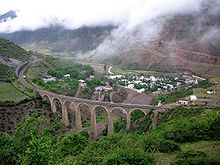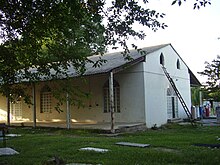Bābol
| Bābol | ||
|---|---|---|
|
|
||
| Basic data | ||
| Country: |
|
|
| Province : | Māzandarān | |
| Coordinates : | 36 ° 33 ' N , 52 ° 41' E | |
| Height : | 3 m | |
| Residents : | 250,217 (2016) | |
| Time zone : | UTC +3: 30 | |
Bābol ( Persian بابل/ bɔːˈbol /, until 1927 also Bārforūsch ) is a city in the Iranian province of Māzandarān and a seaside resort on the Caspian Sea . Bābol is located on the river of the same name and is about 30 km from the provincial capital Sāri . The city is the main trading center of Māzandarāns (once all of northern Iran). Bābol has 250,217 inhabitants (as of 2016). South of the city is the place Ortlāscht , birthplace of Reza Shah Pahlavis .
history
The first name of Bābol was Māmitrā ( Persian ماميترا, 'Place Mithras', corresponding to the Iranian deity Mithras ), later in the neo-Persian development Māmtir .
Sources of Iran's history can be seen that in the year 864 n. Chr. Under the against the representatives of the Abbasid Arab caliphs of Baghdad directional resistance of the Iranian nobility and large parts of the population of the region, the prince Abdollah Ibn Vendad-Omid the Calling people of the city to join the resistance with great success. The present city, which according to the historian Sayyed Zahiruddin Mar'ashi (1413-1488 n. Chr.) In his time Bārforūschdeh called, from which the later Bārforūsch in the 16th century emerged, attained the peak of its economic development in the late 18th century due to trade with Russia . Under the Zand dynasty , the city became the capital of the province of Māzandarān . Favored by the enmity of the later Qajar dynasty against the former ruling family of the Zand and by the sympathy of the city population for the overthrown Zand dynasty, the provincial capital was relocated to Sāri again at a later time . As a result of this and other decisions (e.g. the non-connection to the Trans-Iranian Railway built by Reza Shah in the early 20th century), the city lost some of its importance in later times.
As part of the confrontation of the Persian government under the Qajar dynasty with the religious movement of Babs and ahead of the later burgeoning community of Baha'is took place in the years 1848 and 1849 to a military conflict between the regular armed forces and the followers of Babism near the city. Here the Babis suffered great losses. The confrontation went down in history as "the event of the fortress of Sheikh Tabarsi " ( Vāghe'ehe Ghal'ehe Sheikh Tabarsi ), since the mausoleum of the spiritual scholar Sheikh Tabarsi (Ahmad Ibn Abitaleb Tabarsi) had served as the scene of the conflict.
However, the city later had a relatively high proportion of non-Islamic residents, especially citizens of the Jewish faith and Baha'is .


economy
Along with Tonekābon, Bābol is an essential center of Iranian citrus fruit production . Also tea and rice are grown in the surrounding countryside. Tobacco , silk , cotton and soy were also grown until the 1980s .
Universities and colleges
The city's leading universities, colleges and institutes should be mentioned:
- Babol University of Medical Sciences
- Noshirvani Technological University
- Mazandaran University of Science and Technology
- Babol Free University
- Institute for Applied Science in Art and Culture
- Payame Noor University of Babol
- University of Applied Sciences - Babol
- University of Teaching Staff Rajai Babol
- Mazandaran Institute of Technology
- Rahedanesh Institute for Higher Education
- Tabari Institute for Higher Education
- Institute of Applied Science Jahad Daneshgahi
- Aryan Institute of Science and Technology
- Imam Sadiq Vocational College, Babol
- Vocational college Sama, Babol
- AzZahra Vocational College, Babol
Attractions
Ruins of the palace of the Safavid Persian emperor Shah Abbas I lie in the south of the old city center. Other sights include the Mohammad Hassan Khān Bridge, built under the Qajar conqueror of the city Mohammad Hassan Khān (1722–1758), father of the future emperor Shah Aga Mohammed Khan . The imperial palace from the time of the Persian dynasty of the Pahlavis, today part of the University of Medical Sciences, and the Ganjineh Museum are other ancient attractions of the city.
sons and daughters of the town
- Delkash (1924-2004), singer and actress
- Imam-Ali Habibi (* 1931), wrestler and politician
- Towhidi Tabari (* 1964), calligrapher and ornament painter
- Afschin (* 1978), singer
- Bashir Asgari Babajanzadeh (* 1989), wrestler
- Keyvan Ghanbarzadeh (* 1990), high jumper
- Sousan Hajipour (* 1990), Taekwondoin
Individual evidence
- ↑ Bābol - data profile and name variants . bevoelkerungsstatistik.de. Retrieved May 29, 2012.
- ↑ Iran: Larger Cities - Population Statistics in Maps and Tables. Retrieved April 23, 2018 .
- ↑ a b Tārīkh-e Tabarestān va Ruyān va Māzandarān. Sayyed Zahiruddin Mar'ashi. Publisher: MH Tasbihi, Shargh Publishing Company. Tehran, 1966
- ^ Bābol. Dr. Jafar Niaki. ISBN 964-90955-1-9 . Ramrang publishing house. 2000
- ^ Māzandarān and Astarābād. Hyacinth Louis Rabino (1877–1950)
- ↑ Vaqi'iy-i-Qal'yi-i-Shaykh Tabarsi. Siyamak Zabihi-Moghaddam. Asr-i Jadid Publisher. Darmstadt, 2002
- ↑ Delkash in the Internet Movie Database (English)
literature
- X de Planhol: Bābol . In: Encyclopædia Iranica . Routledge & Kegan Paul Inc., New York, NY 1988, pp. 317-318 .
Web links
- S. Blair: BĀBOL . In: Ehsan Yarshater (Ed.): Encyclopædia Iranica (English, including references)
- Website of the Cultural Heritage News Agency (CHN-Press) on the province of Māzandarān with information on Bābol ( Memento from June 18, 2009 in the Internet Archive )


